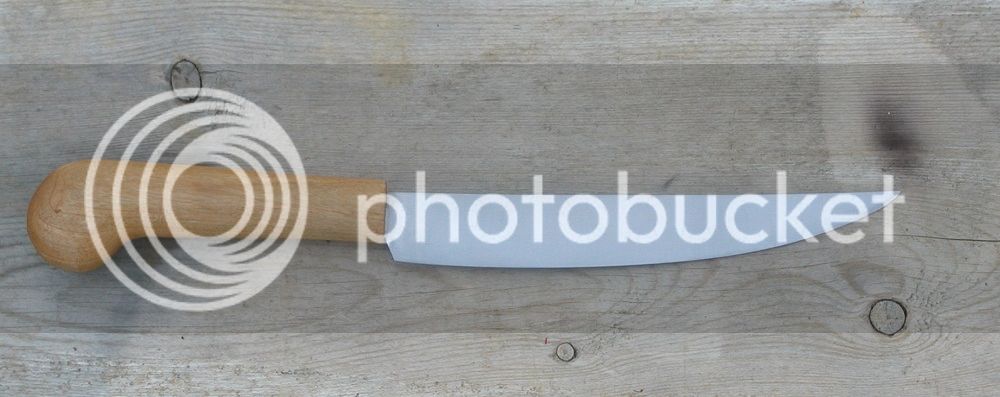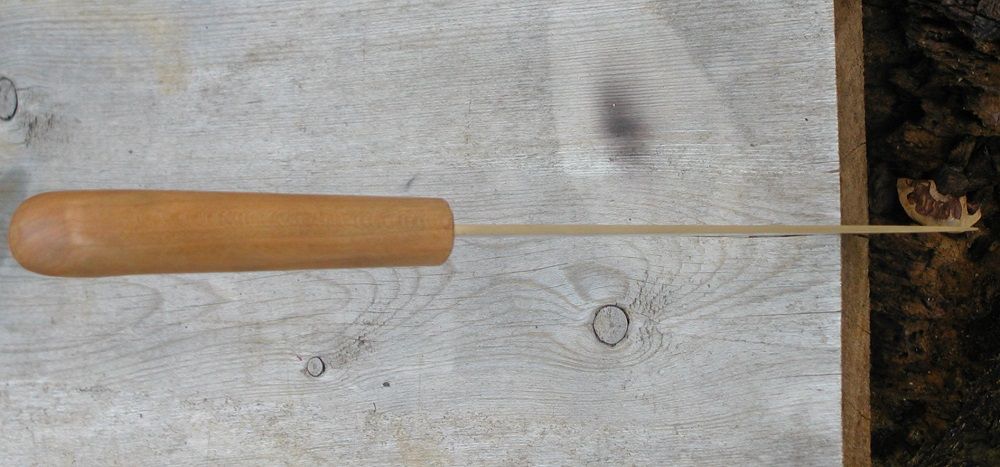I finally managed to actually finish a knife! Well, kind of - it needs sharpening and a sheath yet...
Here is the blade:

And here is the completed knife:


The blade is about 6 3/16" long, 7/8" wide,just a hair over 1/10" thick at the spine nearest the handle, and is finished with 220 grit sandpaper with the scratches running short-ways to mimic the grinding pattern from an 18th century industrial wheel. The steel was a piece of O-1 drill rod and the handle is made from cherry held on with 18th century-style cutler's epoxy made with pine pitch and beeswax. The whole thing weighs about 2 1/2 ounces.
This one is based on a knife owned by Nathan Kobuck and illustrated on his blog several years ago: http://buffalotrace1765.blogspot.com/2010/08/so-today-i-got-some-kewl-stuff-in-mail.html
Apparently there have been a number of them found at Fort Stanwix as well. I have been working off the assumption that this patternwas a trade knife of some kind, manufactured in England and shipped here. The result is pretty close to Kobuck's example, I think, but has a bit more of a belly due to a grinding error.
The handle requires a bit of explanation.
There have been no original handles found, so apart from knowing that they didn't have ferrules no one knows what they looked like, though a turned handle seems quite likely to me. I don't have a lathe, though, and I didn't want to use an (expensive) piece of European or tropical wood on a guess. I ended up making a "user-made replacement" handle out of domestic hardwood - the idea is that the original handle wasn't dried completely and split when introduced to a new climate or was otherwise destroyed, and the owner, rather than discard a perfectly good knife, quickly made a new one out of some wood he had readily available. The wood is scraped and I didn't bother trying to make the handle perfectly symmetrical, though it is close enough not to be immediately noticeable. As a matter of fact, while shaping the handle I cut into a charred spot from burning the hole for the tang, but since the actual hole isn't near there and it seems structurally sound, I went ahead and used it anyway on the logic that my fictional woodsman wouldn't have worried about it.
It isn't all that pretty, I admit, but I think it will be a good user and is closer to what was actually carried out in the woods than some of the fine art knives I have seen here and elsewhere. It is certainly an improvement on my first forged knife, which is picturesque but weighs three times as much and has too much metal behind the edge for easy sharpening.
Here is the blade:

And here is the completed knife:


The blade is about 6 3/16" long, 7/8" wide,just a hair over 1/10" thick at the spine nearest the handle, and is finished with 220 grit sandpaper with the scratches running short-ways to mimic the grinding pattern from an 18th century industrial wheel. The steel was a piece of O-1 drill rod and the handle is made from cherry held on with 18th century-style cutler's epoxy made with pine pitch and beeswax. The whole thing weighs about 2 1/2 ounces.
This one is based on a knife owned by Nathan Kobuck and illustrated on his blog several years ago: http://buffalotrace1765.blogspot.com/2010/08/so-today-i-got-some-kewl-stuff-in-mail.html
Apparently there have been a number of them found at Fort Stanwix as well. I have been working off the assumption that this patternwas a trade knife of some kind, manufactured in England and shipped here. The result is pretty close to Kobuck's example, I think, but has a bit more of a belly due to a grinding error.
The handle requires a bit of explanation.
There have been no original handles found, so apart from knowing that they didn't have ferrules no one knows what they looked like, though a turned handle seems quite likely to me. I don't have a lathe, though, and I didn't want to use an (expensive) piece of European or tropical wood on a guess. I ended up making a "user-made replacement" handle out of domestic hardwood - the idea is that the original handle wasn't dried completely and split when introduced to a new climate or was otherwise destroyed, and the owner, rather than discard a perfectly good knife, quickly made a new one out of some wood he had readily available. The wood is scraped and I didn't bother trying to make the handle perfectly symmetrical, though it is close enough not to be immediately noticeable. As a matter of fact, while shaping the handle I cut into a charred spot from burning the hole for the tang, but since the actual hole isn't near there and it seems structurally sound, I went ahead and used it anyway on the logic that my fictional woodsman wouldn't have worried about it.
It isn't all that pretty, I admit, but I think it will be a good user and is closer to what was actually carried out in the woods than some of the fine art knives I have seen here and elsewhere. It is certainly an improvement on my first forged knife, which is picturesque but weighs three times as much and has too much metal behind the edge for easy sharpening.
Last edited by a moderator:




